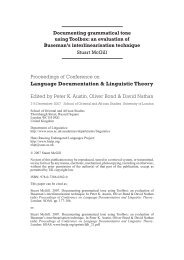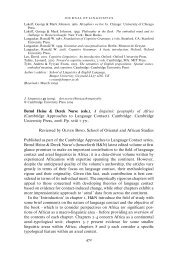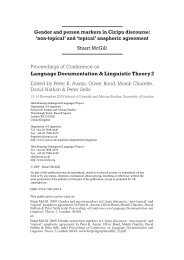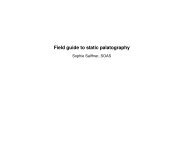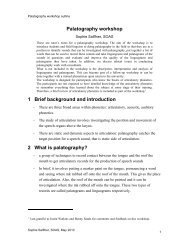Language Documentation & Linguistic Theory - Hans Rausing ...
Language Documentation & Linguistic Theory - Hans Rausing ...
Language Documentation & Linguistic Theory - Hans Rausing ...
You also want an ePaper? Increase the reach of your titles
YUMPU automatically turns print PDFs into web optimized ePapers that Google loves.
<strong>Language</strong> revitalization or language fossilization?<br />
Some suggestions for language documentation<br />
from the viewpoint of interactional linguistics<br />
Yuko Sugita<br />
Proceedings of Conference on<br />
<strong>Language</strong> <strong>Documentation</strong> & <strong>Linguistic</strong> <strong>Theory</strong><br />
Edited by Peter K. Austin, Oliver Bond & David Nathan<br />
7-8 December 2007 School of Oriental and African Studies, University of London<br />
School of Oriental and African Studies<br />
Thornhaugh Street, Russell Square<br />
London WC1H 0XG<br />
United Kingdom<br />
Department of <strong>Linguistic</strong>s:<br />
http://www.soas.ac.uk/academics/departments/linguistics<br />
<strong>Hans</strong> <strong>Rausing</strong> Endangered <strong>Language</strong>s Project:<br />
http://www.hrelp.org<br />
elap@soas.ac.uk<br />
© 2007 Yuko Sugita<br />
No part of this publication may be reproduced, stored in a retrieval system, or transmitted,<br />
on any form or by any means, electronic, mechanical, photocopying, recording or otherwise,<br />
without the prior permission of the author(s) of that part of the publication, except as<br />
permitted by UK copyright law.<br />
ISBN: 978-0-7286-0382-0<br />
This paper can be cited as:<br />
Yuko Sugita. 2007. <strong>Language</strong> revitalization or language fossilization? Some suggestions<br />
for language documentation from the viewpoint of interactional linguistics. In Peter K.<br />
Austin, Oliver Bond & David Nathan (eds) Proceedings of Conference on <strong>Language</strong><br />
<strong>Documentation</strong> and <strong>Linguistic</strong> <strong>Theory</strong>. London: SOAS. pp. 243-250.<br />
or:<br />
Yuko Sugita. 2007. <strong>Language</strong> revitalization or language fossilization? Some suggestions for<br />
language documentation from the viewpoint of interactional linguistics. In Peter K. Austin,<br />
Oliver Bond & David Nathan (eds) Proceedings of Conference on <strong>Language</strong> <strong>Documentation</strong><br />
and <strong>Linguistic</strong> <strong>Theory</strong>. London: SOAS. www.hrelp.org/eprints/ldlt_28.pdf
A language revitalization or language fossilization?<br />
Some suggestions for language documentation from the viewpoint<br />
of interactional linguistics<br />
YUKO SUGITA<br />
Institute of East Asian Studies, University of Duisburg-Essen<br />
1. INTRODUCTION<br />
The issues addressed in this paper are the result of an application for funding of<br />
Ryukyuan language documentation in Japan. 1 In this project, it is our intended<br />
endeavor to develop theory and method of ‘documentation for revitalization’<br />
(Grenoble & Whaley 2006: 68). This paper calls for the following perspective<br />
changes in endangered language documentation: a) moving away from languageas-system-view<br />
to language-as-practice-perspective; b) applying INTERACTIONAL<br />
LINGUISTICS as a potential approach to documentation studies; c) adding natural<br />
interactional data, especially intergenerational interaction, to the objects of<br />
documentation in order to support language revitalization efforts in the<br />
community.<br />
Having exchanged information with several young researchers working on<br />
the documentation of endangered languages, I have come to note a lack of<br />
consideration of linguistic interaction. The main emphasis of the endangered<br />
language study remains on documenting an endangered language by eliciting data<br />
through interviews or story-telling of the oldest informants. Primarily, the data is<br />
to serve the research purpose of those responsible for the documentation, hence,<br />
for professional linguists. The notion of an ideal speaker and language as<br />
homogenous and monolithic objects of contemplation continue to be lurking<br />
prominently in the background of much endangered language research. Wright<br />
(2007) calls such perspective ‘language as system’ as opposed to ‘language as<br />
practice’, stressing the importance of the latter for linguistic research. From the<br />
viewpoint of interactional linguistics, a change of perspective in endangered<br />
language documentation and analysis appears desirable. This is so because<br />
empirical interactional data, in any given natural setting, abound in situated<br />
meanings, patterns of language use, language attitudes and cultural knowledge.<br />
These issues, I argue, are highly relevant for language maintenance and<br />
revitalization.<br />
In this paper, I will briefly introduce some background information on and<br />
methods of interactional linguistics (Section 2) and then give an idea of<br />
1 The term ‘Ryukyuan’ is used for language varieties in Ryukyu Islands. Ryukyuan is the only<br />
language which is proven to be genealogically related to Japanese so far. Both languages have<br />
developed independently for more than 1500 years and mutual intelligibility with any Japanese<br />
variety is not available. Due to the historical and political reasons, however, the Ryukyuan<br />
language is often regarded as and spoken in terms of a dialect (h�gen) of Japanese both by the<br />
Japanese linguistic authority and by the local communities (cf. Kamimura 1997, Heinrich 2004 for<br />
details).<br />
243
LANGUAGE DOCUMENTATION AND LINGUISTIC THEORY<br />
documenting intergenerational communication (Section 3) introducing a data<br />
analysis of our pilot study (Section 4). Finally, it discusses how such analysis<br />
could contribute to the revitalization efforts in the local community (Section 5).<br />
2. THEORETICAL AND METHODOLOGICAL CONSIDERATIONS<br />
As emphasized in the studies aiming at establishing ‘documentary linguistics’ as<br />
an independent research field in its own right (cf. Himmelmann 2004, Gippert et<br />
al. 2006), ethnography of communication has been regarded as one of the key<br />
frameworks for language documentation which transcends descriptive approaches<br />
(Himmelmann 2004: 62, Hill 2006). The direction of work such as proposed by<br />
Himmelmann and Hill are reminiscent of a research field which was originally<br />
initiated in Germany. This approach is called interactional linguistics and has<br />
developed over the past ten years as an interface between ethnomethodological<br />
conversation analysis, ethnography of communication and functional linguistics<br />
(cf. Selting and Couper-Kuhlen 2000, Couper-Kuhlen and Selting 2001).<br />
Following this approach, documentation of naturally occurring verbal/nonverbal<br />
interaction always precedes further analysis open to a wide range of research<br />
fields such as prosodic or segmental phonetics, phonology, morphology, lexical<br />
semantics, and pragmatics as well as language acquisition, and sociolinguistic,<br />
sociological and ethnographical issues (Selting and Couper-Kuhlen 2000: 76).<br />
Today we find various kinds of interactional linguistic studies across research<br />
domains, and, according to Himmelmann (2004: 50-51), these domains contribute<br />
to the formation of the documentation theory. At the heart of interactional<br />
linguistics is thereby the aim of revealing how specific linguistic phenomena are<br />
functioning in organizing the incremental and situational interaction on the basis<br />
of the documented data. Its concept of language, methods of transcribing data, as<br />
well as the research approach working rather heuristically on data (Deppermann<br />
2001: 20) are congruent with the framework to be established for documentary<br />
linguistics as proposed in Himmelmann (2004).<br />
3. DOCUMENTING INTERGENERATIONAL INTERACTION<br />
If we take seriously the idea of language practice as influenced by socio-economic<br />
and political changes which constantly take place, then language change in local<br />
communities should deserve our attention. Intergenerational activities should be<br />
the object of documentation more frequently as commonly practiced.<br />
Documenting a language as practice implies admitting the fact that ‘new forms of<br />
language are constantly developing in increasingly complex social and cultural<br />
relations’ (Patrick 2007: 125). In Okinawa, for example, there emerges<br />
Ryukyuan-Japanese as a new variety among the younger generation (Heinrich<br />
2004: 174, �no 1995, Takaesu 2005). We are facing the fact that most young<br />
people under 40 years of age in Okinawa have very limited proficiency in the<br />
local language (Ryukyu Shimpo-sha 2006: 26). The young generation is<br />
244
YUKO SUGITA<br />
purposefully shifting away from Standard Japanese which replaced the local<br />
language in many domains to a mixed language Uchinaa-Yamatuguchi (cf.<br />
Heinrich 2007a for this language shift and Auer 1999 for language mixing).<br />
Takaesu (2002: 152) defines it as the local variety of Standard Japanese with<br />
morphological and lexical as well as grammatical interferences from Ryukyuan.<br />
From the language-as-practice-view, documentation should include such a new<br />
variety as well. From the language-as-system view, the variety would be labeled<br />
as a ‘non-authentic code’ and might fail to find the attention it deserves. Note that<br />
at present not one single empirical study of Uchinaa-Yamatuguchi language use<br />
exists. Lack of attention is not only to be found among many linguists; the local<br />
activists promoting language revitalization in the Ryukyu Islands are also critical<br />
towards Uchinaa Yamatuguchi. To change this requires, it seems to me, a change<br />
of perspective: the language revitalization activities should make full usage of the<br />
documentation and analysis of the language choices of the younger generation. In<br />
investigating the conditions under which the younger generation can be motivated<br />
to use the local language, researchers can, for instance, give advice to the local<br />
community in developing language education materials. As stated by Heinrich<br />
(2007b), many speakers of endangered languages themselves care about the loss<br />
of their heritage language. One survey report of people in Okinawa Prefecture in<br />
2006 reveals that the majority of Okinawa people state that they feel an<br />
attachment to the local language and that they want their children be capable of<br />
using it (Ryukyu Shimpo-sha 2006: 25, 27). Specialists of different disciplines<br />
working on endangered languages should be aware of the possibilities and<br />
necessity to serve the local community with concrete ideas or methods for<br />
revitalization and REGENERATION efforts (see Spolsky 2003 for the term<br />
‘regeneration’). After these methodological considerations, let us now turn to the<br />
empirical part in which intergenerational interaction is the target of<br />
documentation and analysis.<br />
4. PILOT STUDY<br />
As a pilot study to develop documentation methods for language revitalization,<br />
several analyses of intergenerational interaction collected from local radio<br />
broadcasting have been conducted. They show certain patterns of choice in<br />
language by the younger generation. In what follows, an example will be<br />
discussed to illustrate a possible documentation and analysis according to<br />
interactional linguistics. The data is culled from an internet streaming video of<br />
Radio Okinawa, local radio broadcasting in Okinawa. The interaction, a short talk<br />
between the newscaster and the radio host, follows immediately after the local<br />
news in a local variety of Ryukyuan language, and lasts approximately two<br />
minutes. The topic in the data is a local idiomatic expression from Ryukyuan,<br />
‘nankuru nai sa.’ The male radio host M, who was 38 at the time of the recording,<br />
and the male newscaster O, who was 81, are talking about the usage of this and<br />
other similar expressions. The data in the Appendix is the last part of this short<br />
discussion, where M is talking about one of the two different usages of ‘nankuru<br />
245
LANGUAGE DOCUMENTATION AND LINGUISTIC THEORY<br />
nai sa.’ (Note that the way to use (practise) this expression needs to be explained.)<br />
My focus is on one phenomenon in which M switches language. M is not a fullspeaker<br />
of the local Ryukyuan variety like the majority of the younger generation<br />
of Okinawa. However, his listening comprehension is much better than younger<br />
listeners of his radio programme. Especially when interacting with the older<br />
newscasters who speak both a Ryukyuan variety and Standard Japanese, however,<br />
M’s language tends to be more Japanese than Ryukyuan-Japanese. The elderly<br />
newscaster O mostly speaks Japanese in the interaction. This is due to the special<br />
setting in the media which has to be taken into account when analyzing the data. 2<br />
Nevertheless, M sometimes switches into Ryukyuan. This choice is not only on<br />
the morphological, syntactical or lexical level, but also on the level of action.<br />
As the data shows (with Ryukyuan utterances shown in square brackets),<br />
reported speech is mostly uttered in Ryukyuan by M. This is also the case in other<br />
data. This phenomenon is not novel, but has frequently been observed in studies<br />
on code-switching (cf. Gumperz 1982: 75-76). The features of Ryukyuan such as<br />
prosodic features, idiomatic expressions, modals, and evaluative expressions are<br />
embedded in actions such as speech reproduction or description of the situation or<br />
persons. This implies that those kinds of actions can easily inspire younger<br />
generation to speak in Ryukyuan. When the speaker is involved in an event which<br />
s/he should describe, or reproduce what was experienced, s/he is likely to use the<br />
language used in the event. Such findings can be useful for the planning of<br />
bilingual education which is obviously needed in Okinawa for language<br />
revitalization.<br />
In addition to the code switching phenomenon, this small excerpt actually<br />
reveals another interesting phenomenon, namely awareness of language use. The<br />
short discussion in the radio programme, which is very popular in Okinawa, must<br />
have also stimulated local people to be aware of their own language use.<br />
5. LANGUAGE DOCUMENTATION FOR REVITALIZATION<br />
Although our pilot study is a special case, in that the interaction in a radio<br />
programme is taken as an object of study, it nevertheless reveals that the study of<br />
interactional linguistics can be a potential approach for documenting endangered<br />
languages as practice. Researchers should document and analyze intergenerational<br />
interaction to identify crucial factors involved in successful transmission of local<br />
languages. In so doing and where there is support from the local community,<br />
fieldworkers can also promote intergenerational activities in the community to<br />
enhance natural language transmission across generations (cf. Fishman 1991 for<br />
the importance of restoring local language in intergenerational communication).<br />
Applying the results of the pilot study, I would like to propose the following<br />
steps to take as one possible educational and research practice:<br />
2 For example, most of the listeners of the radio programme are non-speakers of Ryukyuan and<br />
this influences language choices. For detailed analysis of the framework of broadcasting, see the<br />
concept of FOOTING in Goffman (1981).<br />
246
YUKO SUGITA<br />
1. Promotion of intergenerational activities concerning the local language, local<br />
culture and tradition (such as in kindergartens, schools, community centers or<br />
by means of media).<br />
2. As follow-up activities, the younger generation could be asked to tell about<br />
the experience they had from the intergenerational activities, in families, in<br />
schools or other activity groups. They should report what the older generation<br />
talked about, explain the situations, or describe what they saw or heard.<br />
3. By documenting intergenerational activities as well as the output of the<br />
younger generation after the activities, researchers should be able to identify<br />
crucial psycholinguistic/interactional linguistic factors involved in successful<br />
transmission of local languages for further language planning.<br />
If linguists remain uninformed about the fact that languages are in no way<br />
self-contained linguistic entities or systems (Auer 2007: 320), they might succeed<br />
in fossilizing endangered languages and, what is more, might fail in supporting<br />
the local community’s attempts at language revitalization. It is necessary for<br />
researchers to tackle the question of why the situation has hardly changed since<br />
Spolsky (1978: 332) lamented that most students of endangered languages ‘felt<br />
little responsibility to preserve them except in grammar books and archives.’<br />
Appendix: Data 3<br />
(1) M [v] • [[Sakkoo]] ganbat-te shigoto shi-te. i/ i-te:<br />
M [mt] [[very]] make.effort-PAR job do-DUR-PAR<br />
M [en] • ‘To the person who is working [[very]] hard, but<br />
(2) O [v] N:.<br />
O [mt] yeah<br />
O [en] Yeah.<br />
M [v] nayan-de: [‘Caasju ga yaa. Caasju ga yaa.’] tte<br />
M [mt] worry-PAR [what should I do? what should I do?] QUT<br />
M [en] being worried like [‘What should I do? What should I do?’] being<br />
(3) M [v] na/ mainichi nayan-de-ru hito ni: .hh [[‘Daijoobu<br />
M [mt] every day worry-DUR-ATT person DAT [[take it easy<br />
M [en] worried every day, (you say) .hh [[‘Take it<br />
(4) M [v] yo’.]] [Anshi] nayan-de. mo [yaa,] isshookenmei<br />
M [mt] FP]] [such] worry-CON AUG hard<br />
M [en] easy’.]] Don’t worry [so much]. [When you are working so]<br />
3 Ryukyuan is romanized according to the orthography established by the Okinawa Center of<br />
<strong>Language</strong> Study.<br />
247
LANGUAGE DOCUMENTATION AND LINGUISTIC THEORY<br />
(5) O [v] ‘kuru naisa’.<br />
O [mt] [will work out]<br />
O [en] [‘will work out’.]<br />
M [v] [s-oo-ru bun] .hh [‘nankuru nai sa’] to.<br />
M [mt] [do-DUR-ATT portion] [it will work out] QUT<br />
M [en] hard, .hh [‘it will work out’.]<br />
(6) O [v] N:.<br />
O [mt] yeah<br />
O [en] ‘Yeah.’<br />
M [v] .hh Iu tsukai-kata: ryhoohoo aru wake<br />
M [mt] such use-way both exist it is that<br />
M [en] .hh ‘It is that we have two different usages,<br />
(7) O [v] Ryoohoo aru.<br />
O [mt] both exist<br />
O [en] ‘We have both.’<br />
M [v] desu yo ne:.<br />
M [mt] VPRT.FRM FP FP<br />
M [en] right?’<br />
(Source: H�gen Ny�su ‘Dialect News’ on Radio Okinawa (ROK), Video<br />
Streaming http://www.okinawabbtv.com/news/h_news.htm 26/01/07)<br />
Abbreviations and Symbols<br />
Transliteration Morpheme category Forms in Japanese/Ryukyuan<br />
ATT nominal attribute inflection V-ru, V-ta, Adj-i, Adj-katta<br />
AUG augment (Ryukyuan) yaa<br />
CON concessive construction V-te mo, Adj-kute mo, N de mo<br />
DAT dative particle ni<br />
DUR durative construction V-te i-ru > V-te-ru<br />
FP final particle ne, yo, (Ryukyuan) sa, yaa<br />
PAR participial Verb-te, Adj-kute<br />
QUT quotative particle to<br />
VPRT.FRM formal particle verb. desu<br />
Symbols<br />
[v] verbal line<br />
[mt] morphological transliteration<br />
[en] translation in English<br />
[…] Ryukyuan (variation)<br />
[[…]] Ryukyuan-Japanese<br />
pause, less than 0,3 seconds<br />
: syllable lengthening<br />
/ repair<br />
.hh inhalation<br />
248
YUKO SUGITA<br />
REFERENCES<br />
Auer, Peter. 1999. From codeswitching via language mixing to fused lects: toward<br />
a dynamic typology of bilingual speech. International Journal of<br />
Bilingualism Vol. 3, No. 4, 309-332.<br />
Auer, Peter. 2007. The monolingual bias in bilingualism research – or: why<br />
bilingual talk is (still) a challenge for linguistics. In Monica Heller (ed.),<br />
Bilingualism: A Social Approach, 319-339. Basingstoke: Palgrave<br />
Macmillan.<br />
Deppermann, Arnulf. 2001. Gespräche analysieren: Eine Einführung. Opladen:<br />
Leske+Büdrich.<br />
Fishman, Joshua A. 1991. Reversing <strong>Language</strong> Shift: Theoretical and Empirical<br />
Foundations of Assistance to Threatened <strong>Language</strong>s. Clevedon:<br />
Multilingual Matters.<br />
Gippert, Jost, Nikolaus P. Himmelmann & Ulrike Mosel (eds.). 2006. Essentials<br />
of <strong>Language</strong> <strong>Documentation</strong>. Berlin: Mouton de Gruyter.<br />
Goffman, Erving. 1981. Forms of Talk. Oxford: Basil Blackwell.<br />
Grenoble, Lenore A. & Lindsay J. Whaley. 2006. Saving <strong>Language</strong>s: An<br />
Introduction to <strong>Language</strong> Revitalization. Cambridge: Cambridge<br />
University Press.<br />
Gumperz, John. 1982. Discourse strategies. Cambridge: Cambridge University<br />
Press.<br />
Heinrich, Patrick. 2004. <strong>Language</strong> planning and language ideology in the Ry�ky�<br />
Islands. <strong>Language</strong> Policy 3, 153-179.<br />
Heinrich, Patrick. 2007a. Look who’s talking. <strong>Language</strong> choices in the Ry�ky�<br />
Islands. Essen: LAUD.<br />
Heinrich, Patrick. 2007b. ‘Wanne Uchinanchu – I am Okinawan’: Patrick<br />
Heinrich interviews Fija Bairon on Okinawa’s endangered language and<br />
culture. Japan Focus (http://www.japanfocus.org/).<br />
Hill, Jane H. 2006. The ethnography of language and language documentation. In<br />
Jost Gippert, Nikolaus P. Himmelmann & Ulrike Mosel (eds.), Essentials<br />
of <strong>Language</strong> <strong>Documentation</strong>, 113-128. Berlin: Mouton de Gruyter.<br />
Himmelmann, Nikolaus P. 2004. Documentary and descriptive linguistics. In<br />
Osamu Sakiyama & Fubito Endo (eds.), Lectures on Endangered<br />
<strong>Language</strong>s 5: From Tokyo and Kyoto Conference 2002, ELPR 2004 C005,<br />
37-83. Kyoto: ELPR.<br />
Himmelmann, Nikolaus P. 2006. <strong>Language</strong> documentation: What is it and what is<br />
it good for? In Jost Gippert, Nikolaus P. Himmelmann & Ulrike Mosel<br />
(eds.), Essentials of <strong>Language</strong> <strong>Documentation</strong>, 1-30. Berlin: Mouton de<br />
Gruyter.<br />
Kamimura, Yukio. 1997. Ryukyu rett� no gengo: s�setsu (Ryukyuan <strong>Language</strong>:<br />
General Introduction). In Takashi Kamei, Rokuro Kawano & Eiichi Chino<br />
(eds.) Nihon Rett� no Gengo: Gengogaku Daijiten Serekushon (<strong>Language</strong>s<br />
of Japanese Archipelago: Great <strong>Linguistic</strong> Dictionary Selection), 311-354.<br />
Tokyo: Sanseido.<br />
249
LANGUAGE DOCUMENTATION AND LINGUISTIC THEORY<br />
�no, Makio. 1995. Ch�kan h�gen to shite no uchin� yamatoguchi no is�<br />
(Okinawan Japanese variety as interdialect forms). Gengo Bessatsu 24/12,<br />
178-191.<br />
Patrick, Donna. 2007. <strong>Language</strong> endangerment, language rights and indigeneity.<br />
In Monica Heller (ed.), Bilingualism: A Social Approach, 111-134.<br />
Basingstoke: Palgrave Macmillan.<br />
Ryukyu Shimpo-sha. 2006. Okinawa Kenmin Ishiki Ch�sa Hokokusho (Survey<br />
Report on Consciousness of Okinawan Prefectural Citizens), Naha:<br />
Ryukyu Shimpo-sha.<br />
Selting, Margret & Elizabeth Couper-Kuhlen. 2000. Argumente für die<br />
Entwicklung einer ‘Interaktionalen Linguistik’. OZS /<br />
Gesprächsforschung 1: 76-95. http://www.gespraechsforschung-ozs.de (6<br />
February 2007).<br />
Spolsky, Bernard. 1978. American Indian bilingual education. In Bernard Spolsky<br />
(ed.), Case Studies in Bilingual Education, 332-361. Rowley: Newbury<br />
House Publishing.<br />
Spolsky, Bernard. 2003. Reassessing M�ori regeneration. <strong>Language</strong> in Society 32:<br />
553-578.<br />
Takaesu, Yoriko. 2002. Takaesu, Yoriko. 2002. Uchin� yamatuguchi o megutte<br />
[On Ryukyuan-Japanese]. Kokubungaku 67/7, 151-160.<br />
Takaesu, Yoriko. 2005. Uchin� yamatuguchi (Okinawan Japanese). In Shinji<br />
Sanada & Hiroshi Shoji (eds.) Jiten – Nihon no Tagengo Shakai<br />
[Dictionary of Japan’s Multilingual Society], 265-268. Tokyo: Iwanami.<br />
Wright, Sue. 2007. The right to speak one’s own language: reflections on theory<br />
and practice. <strong>Language</strong> Policy 6, 203-224.<br />
250



